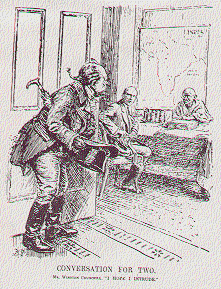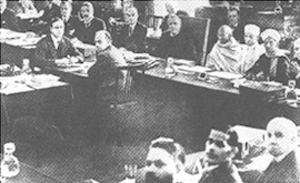CIVIL DISOBEDIENCE MOVEMENT
Round Table Conference, Gandhi- Irwin Pact, Karachi Congress, MacDonald Award & Poona Pact
UPSC –Mains-General –Studies-History of Modern India
· In what way did the Civil Disobedience Movement affect the different provinces of India?
· How did it foster peasant movement in
· What was the Macdonald Award? How was it modified? (1996/15)
· What were the salient features of Gandhi-Irwin Pact? (1997/15)
· Write short notes: Communal Award (1998/2)
· Why did Gandhi launch the Salt Satyagraha in 1930 and with what results? (2001/15)
· Write short notes: Dandi March (2002/2)
|
What is Civil Disobedience ?
Civil disobedience is the active, professed refusal to obey certain laws, demands, and commands of a government, or of an occupying international power. Civil disobedience is a symbolic or ritualistic violation of the law, rather than a rejection of the system as a whole.
|
A variety of criticisms has been directed against the philosophy and practice of civil disobedience. The radical critique of the philosophy of civil disobedience condemns its acceptance of the existing political structure; conservative schools of thought, on the other hand, see the logical extension of civil disobedience as anarchy and the right of the individual to break any law he chooses, at any time.
|
The philosophical roots of civil disobedience lie deep in Western thought: Cicero, Saint Thomas Aquinas, John Locke, Thomas Jefferson, and Henry David Thoreau all sought to justify conduct by virtue of its harmony with some antecedent superhuman moral law.
|
.
The man who most clearly formulated the concept of civil disobedience for the modern world was Mohandas Gandhi. Drawing from Eastern and Western thought, Gandhi developed the philosophy of satyāgraha . First in the Transvaal of South Africa in 1906 and later in India, Gandhi led his people in satyagrahas to obtain equal rights and freedom.
|
CIVIL DISOBEDIENCE MOVEMENT in INDIA
Round Table Conference, Gandhi- Irwin Pact, Karachi Congress, MacDonald Award & Poona
Detailed Timeline
November 1927
|
The Simon Commission was formed by the British Government that included solely the members of the British Parliament to draft and formalize a constitution for India.
|
February 3rd, 1928
|
In Bengal, the opposition to the Simon Commission assumed a massive scale, with a hartal being observed in all corners of the province
|
1st of March, 1928
|
meetings were held simultaneously in all 32 wards of the city Calcutta, spurring people to restore the movement for boycott of British goods.
|
May,1928
|
All-Party Conference was organized in Bombay in May of 1928.
|
December 1928
|
The Indian National Congress pressurized the British government to accept all the parts the Nehru Report
|
1928
|
In Bardoli, the peasants had already taken to satyagraha under the guidance of Sardar Patel in the year 1928.
|
8th of April,1929
|
members of the Hindustan Socialist Republican Association exploded two bombs and fired revolvers in the assembly chamber of the Imperial Legislative Council in Delhi. In response, Lord Irwin published a Public Safety Bill which addressed the menace of the Communist Party by deporting the Englishmen involved and taking legal action against the Indian membership.
|
31st of October,1929
|
Lord Irwin announced on behalf of the British Government that the natural constitutional progress of India was the attainment of Dominion Status.
|
23rd of December 1929
|
Indian nationalists failed in an attempt to blow up Irwin`s train. Lord Irwin met with Mahatma Gandhi, Jawaharlal Nehru, Sardar Vallabhbhai Patel, Mohammad Ali Jinnah and Tel Bahadur Sapru in New Delhi. Erwin however, could not arrive at an agreement for framing a constitution under `Dominion Status`. Indian National Congress also refused to attend the London Round Table Conference due to communal division and the lack of British support for Indian freedom.
|
December 31, 1929
|
The Indian National Congress raised the tricolour flag of India on the banks of the Ravi at Lahore.
|
January 26, 1930
|
The Indian National Congress, led by Gandhi and Jawaharlal Nehru, publicly issued the Declaration of Independence, or Purna Swaraj .First Independence Day observed.
|
Feb 14 ,1930
|
The Working Committee of the INC meets at Sabarmati and passes the Civil Disobedience resolution
|
12th March 1930
|
Gandhi inaugurated The Civil Disobedience Movement by conducting the historic Dandi Salt March. First Phase of Civil Disobedience Movement: March 12, 1930 to March 5, 1931
|
13 March 1930
|
The Viceroy informed the Secretary of State 'Most of my thought at the moment is concentrated upon Gandhi. I wish I felt sure what the right way to deal with him is.'
|
13 March 1930
|
Gandhi and his satyagrahis reached a small village, Aslali, where they were received well by the villagers.
|
6th April 1930
|
Gandhi with the accompaniment of seventy nine satyagrahis, violated the Salt Law by picking up a fistful of salt lying on the sea shore. They manually made salt on the shores of Dandi.
|
May 4–5, 1930
|
Gandhi was arrested on the midnight
|
Nov 30, 1930
|
First Round Table Conference begins in London to consider the report of the Simon Commission
|
March 5,1931
|
Gandhi -Irwin Talks
|
March 23,1931
|
Bhagat Singh, Sukh Dev and Rajguru executed
|
Sept 7,1931
|
Chronology: Indian National Movement ~ UPSC EXAMS
|
Dec 28,1931
|
Mahatma Gandhi returns from London after the deadlock in Second Round Table Conference. Launches Civil Disobedience Movement. Indian National Congress (INC) declared illegal
|
January 1932
|
Gandhi resumed the movement and appealed to the entire nation to join in it
|
Jan 4, 1932
|
Mahatma Gandhi arrested and imprisoned without trial
|
16 August 1932
|
Macdonald Ramsay announced Communal Award
|
Sept 20,1932
|
Mahatma Gandhi begins his epic "Fast unto Death" in jail against the Communal Award and ends the fast on Sept 26 after the Poona Pact
|
Sept. 24, 1932
|
|
Nov 17,1932
|
The Third Round Table Conference begins in London (Nov 17 to Dec 24)
|
July 14th 1933.
|
Mahatma Gandhi released from prison as he begins fast for self-purification. Mahatma Gandi withdrew mass satyagraha . INC suspends Civil Disobedience Movement but authorises Satyagraha by individuals
|
April 7th 1934
|
The movement ceased completely.
|
1934
|
Mahatma Gandhi withdraws from active politics and devotes himself to "Constructive Programmes" (1934-39)
|
Aug 4,1935
|
The Government of India Act, 1935 passed
|
Additional Reading (as per Wikipedia) ----
Partial re-enactment in 2005
To commemorate the Great Salt March, the Mahatma Gandhi Foundation proposed a partial re-enactment of first few kilometers on the 75th anniversary. The event was known as the "International Walk for Justice and Freedom". Mahatma Gandhi's great-grandson Tushar Gandhiand several hundred fellow marchers followed the same route to Dandi. The start of the march on March 12, 2005 in Ahmedabad was attended by Sonia Gandhi, Chairperson of the National Advisory Council, as well as several Indian Cabinet Ministers, many of whom walked for the first few kilometres. The participants halted at Dandi on the night of April 5, with the commemoration ending on April 7.
A series of commemorative stamps were issued on the 75th anniversary of the Dandi March—denomination INR 5, Date of Issue: April 5, 2005.
Dandi March II
A massive protest of 240 miles walk, Dandi March II was organised in California, USA, from March 12 to March 26, 2011 to protest against corruption in India and to support Jan Lokpal bill. The march started at Martin Luther King park at San Diego, proceeded to Los Angeles and culminated at Gandhi statue in San Francisco in USA. The walk was organised by People for Lok Satta, India Against Corruption and volunteers from similar organisations. Six Indians walked all 240 miles while several individuals and members of various organizations joined them to walk different stretches across different towns and cities along the way in California.
Indians in more than 50 cities across the world walked in their respective place on March 26, 2011 to express solidarity to Dandi March II.







